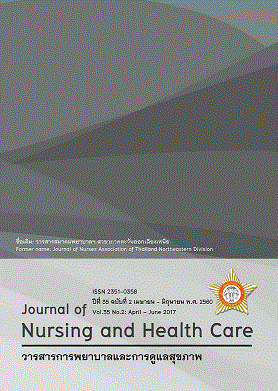การจัดการตนเองของผู้ป่วยความดันโลหิตสูงที่ควบคุมความดันโลหิตไม่ได้ Self-Management among people with uncontrolled hypertension
คำสำคัญ:
โรคความดันโลหิตสูงที่ควบคุมความดันโลหิตไม่ได้ ภาวะสุขภาพ การจัดการตนเอง Uncontrolled hypertension, Health Status Self-managementบทคัดย่อ
บทคัดย่อ
ภาวะความดันโลหิตสูงที่ควบคุมความดันโลหิตไม่ได้ ส่งผลให้เกิดภาวะแทรกซ้อน พิการและเสียชีวิต ซึ่งในปัจจุบันผู้ป่วยความดันโลหิตสูงที่ควบคุมไม่ได้มีจำนวนเพิ่มมากขึ้น ซึ่งมีหลายปัจจัยที่ส่งผลต่อการควบคุมความดันโลหิต ชุมชนเป็นส่วนหนึ่งที่เพิ่มและลดปัจจัยเสี่ยงต่อการสนับสนุนให้ผู้ป่วยจัดการตนเองได้ดีขึ้น การวิจัยเชิงปฏิบัติการแบบมีส่วนร่วมนี้ มุ่งพัฒนากระบวนการเสริมพลังอำนาจชุมชนเพื่อสนับสนุนการจัดการตนเองของผู้ป่วยความดันโลหิตสูงที่ควบคุมความดันโลหิตไม่ได้ โดยมีผู้ร่วมวิจัย 76 คน การดำเนินการวิจัยมี 4 ขั้นตอน ได้แก่ วิเคราะห์สถานการณ์ วางแผน ดำเนินงานและประเมินผล ซึ่งในขั้นตอนวิเคราะห์สถานการณ์มุ่งศึกษาภาวะสุขภาพและการจัดการตนเองของผู้ป่วยที่ควบคุมความดันโลหิตไม่ได้ อาศัยเครื่องมือรวบรวมข้อมูลเชิงคุณภาพ ผ่านการมีส่วนร่วมของชุมชนทุกขั้นตอนโดยการจัดเวทีการเรียนรู้แลกเปลี่ยนประสบการณ์ ผู้วิจัยเป็นผู้อำนวยความสะดวก ใช้การวิเคราะห์ข้อมูลเชิงเนื้อหา
ผลการวิจัย พบว่า 1) ภาวะสุขภาพของผู้ป่วยความดันโลหิตสูงที่ควบคุมความดันโลหิตไม่ได้ แบ่งเป็น 3 กลุ่ม ได้แก่ 1.1) ป่วยด้วยโรคความดันโลหิตสูงไม่มีโรคร่วมแต่มีอาการผิดปกติ (n= 2) 1.2) ป่วยด้วยโรคความดันโลหิตสูงมีโรคร่วมแต่ไม่มีอาการผิดปกติ (n= 5) 1.3) ป่วยด้วยโรคความดันโลหิตสูงมีโรคร่วมและมีอาการผิดปกติ (n= 21) โดยโรคร่วมที่พบได้แก่ เบาหวาน ไขมันในเลือด ไตเรื้อรังและเก๊าต์ ผู้ป่วยส่วนใหญ่มีอาการเหนื่อยอ่อนเพลีย ปวดศีรษะและมึนชาเท้า บางรายที่มีโรคเบาหวานร่วมพบภาวะแทรกซ้อนแผลที่เท้า 2) การจัดการตนเองของผู้ป่วยความดันโลหิตสูงที่ควบคุมไม่ได้ พบว่า ผู้ป่วยประเมินตนเองเพื่อจัดการตนเองจากการสังเกตอาการผิดปกติ ระดับความดันโลหิต ค่าระดับน้ำตาลจากปลายนิ้ว แต่ไม่สามารถประเมินตนเองจากผลการตรวจทางห้องปฏิบัติการและปฏิบัติตามคำสั่งแพทย์ ตั้งเป้าหมายเพียงอยากหายจากโรค อยากหยุดกินยาและไม่อยากเกิดภาวะแทรกซ้อน ซึ่งเป็นเป้าหมายที่วัดไม่ได้ จึงไม่มีการวางแผนปฏิบัติเพื่อให้บรรลุเป้าหมาย เป็นเพียงการปฏิบัติตามคำสั่ง ส่งผลให้ไม่สามารถจัดการตนเองเพื่อลดบริโภคเค็ม เพื่อการควบคุมน้ำหนักและเพื่อลดการสัมผัสบุหรี่และควันบุหรี่ได้
จากผลการวิจัยดังกล่าว ชุมชนเกิดการรับรู้และเข้าใจสภาพปัญหา เกิดความตระหนักร่วมกัน จึงร่วมกันคิดวิเคราะห์สาเหตุของปัญหา ตั้งเป้าหมายและวางแผนแก้ไขปัญหาร่วมกันต่อไป
Abstract
Uncontrolled hypertension is the cause of complications, disability and death. Currently, people with uncontrolled hypertension prevalence is increasing. There are many factors that affect to blood pressure control. Community is an effect which either increases or reduces risk factors to support self management better. The purpose of this participatory action research was to develop the process of community empowerment to support self management among people with uncontrolled hypertension. The participants were 76 people. The research methodology comprised of four steps: situation analysis; planning; operation; and evaluation. The purpose in the situation analysis was to study of the health status and self-management of uncontrolled hypertension. The data were collected using the qualitative tools. Community participation of all stages was arranged to learn using their old experienced forums. The researcher was a facilitator. The data were analyzed using content analysis.
The research results were as follows:
1) Health Status were categorized into three groups including: 1.1) non-complication of hypertension
with other disease (n= 2); 1.2) complication hypertension without any disease (n= 5); 1.3) complication hypertension with other disease (n= 21). Comorbidity diseases are diabetes melitus, dyslipidemia, chronic kidney disease and gout. Most patients were fatigued, headache and neuropathy at feet. Some people with diabetes had foot ulcer complications.
2) Self management among people with uncontrolled hypertension was found that patients assessed oneself for self management by observe their own signs, blood pressure and fasting blood sugar. However, they were not able to evaluate the results of laboratory tests and to follow the medical orders. Their ultimate goals were to be healed from the disease, to discontinue taking medicine and to live without any complications. These goals were not measurable. They lived without any plans to action and to achieve the goals. They only followed the orders. As a result, they were not able to manage themselves for reducing salty food, controlling weight and reducing exposure to cigarettes and cigarette smoke. Based on the findings, the community perceived, understood the problems, initiated the mutual awareness, analyzed the cause of the problems, set their goals and planned to solve problems together in the future



